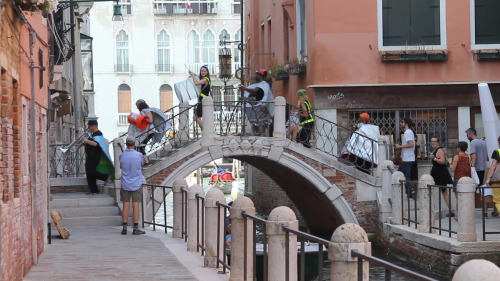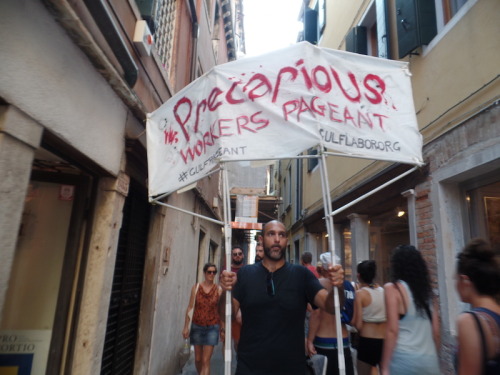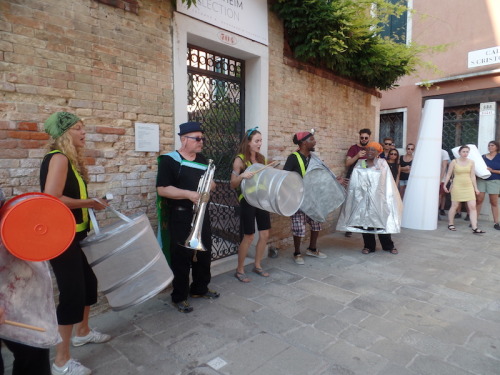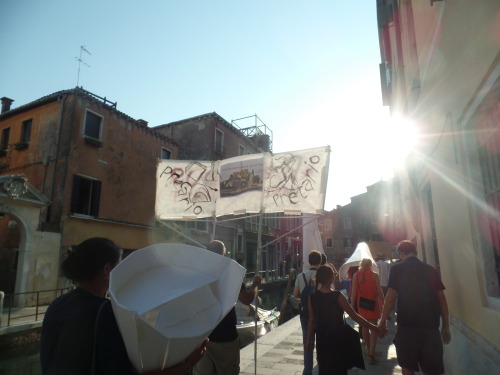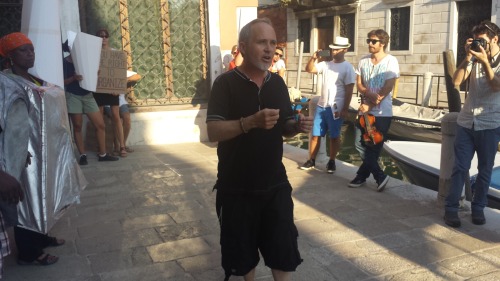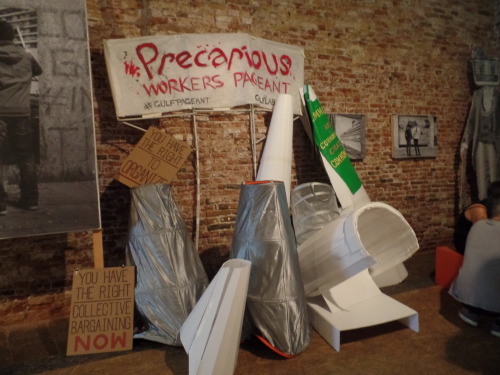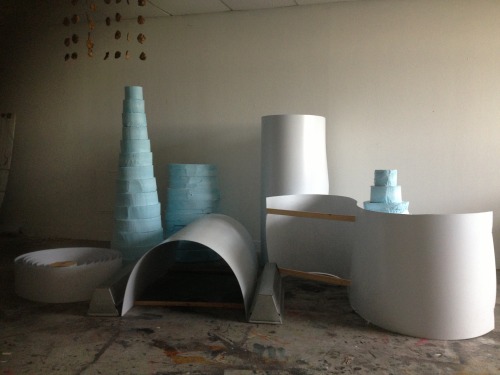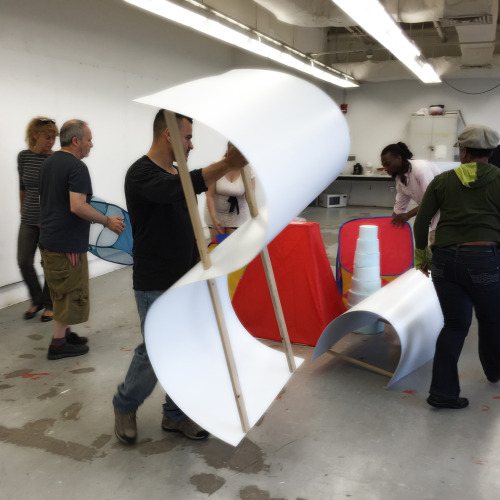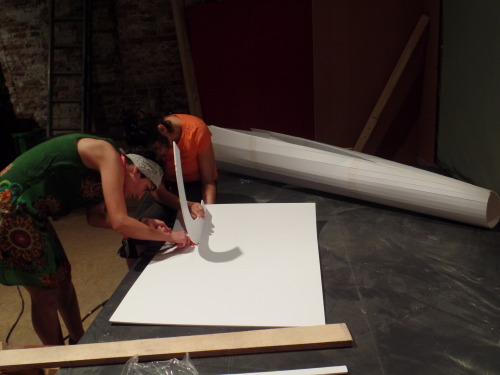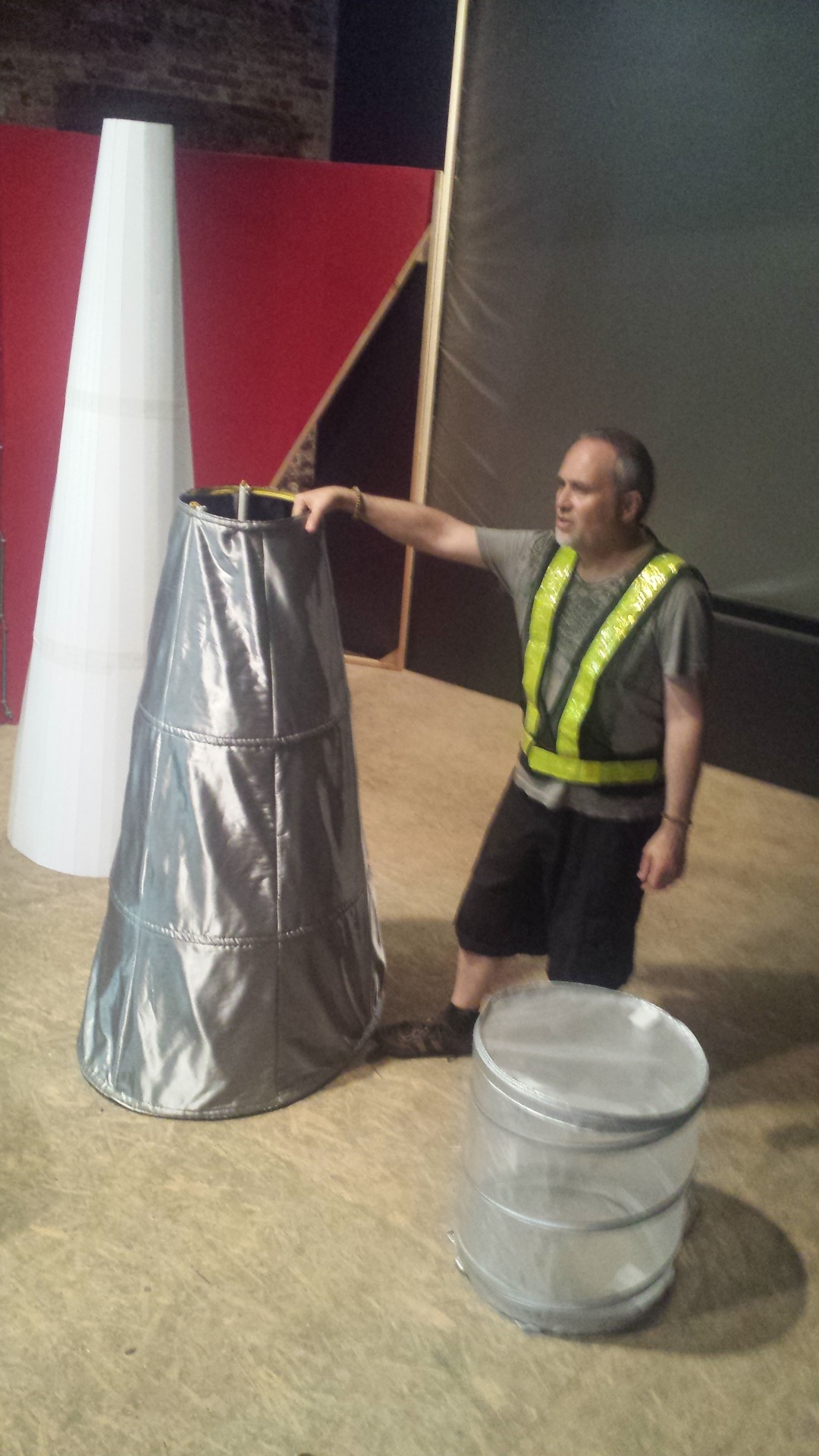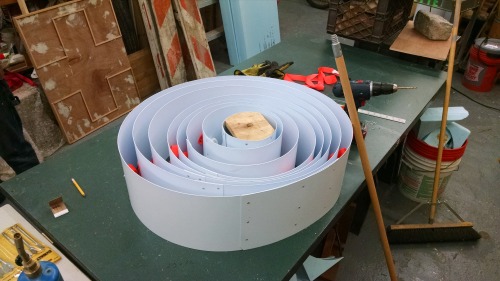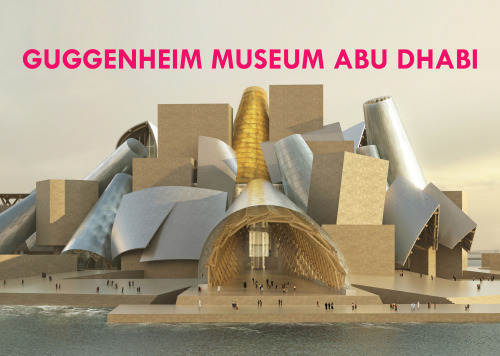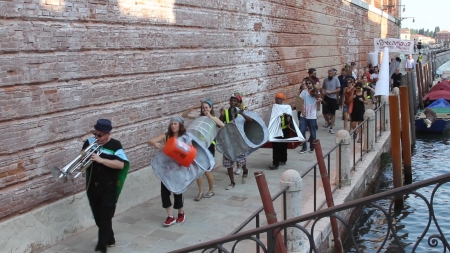Precarious Workers Pageant in Venice!
Precarious Workers Pageant in Venice
The Precarious Workers Pageant- a collaborative project with members of Workers Art Coalition, the Aaron Burr Society, Occupy Museums, G.U.L.F., and Social Practice Queens (CUNY) staged an pageant-intervention at the Venice Biennale this summer.
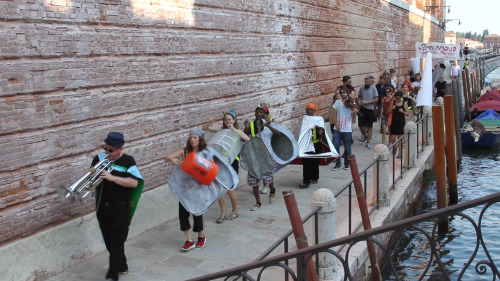
(re-blogged from: http://gregsholette.
Zigzagging across the fever-hot streets of Venice a line of men and women advance. As they march a series of “liberated” geometric shapes and hand-made banners are worn or carried aloft overhead. A man in a blue cape blows a baritone trumpet. Everyone shouts, chants and sings about solidarity with migrant laborers in the Gulf State of Abu Dhabi. In fact, solidarity with precarious labor everywhere is called for. (photos by Setare Arashloo)
The group reveals dual influences. First, the Russian Futurist avant-garde of the early 20th Century, and second, the 1913 Paterson Silk Strike and Pageant, in New Jersey. After weeks of rehearsals this band of NYC based construction workers, students and artists traveled to Italy, marched past the Peggy Guggenheim Collection in the Dorsoduro on August 7th, and then come to a stop at the nearby Gallerie dell’Accademia plaza. At which point the deconstructed architectural elements of Frank Gehry’s new Guggenheim Abu Dhabi they carried with them were reassembled into a circular barricade. And there, inside this temporary public “commons,” a series of speeches, songs, poems and “mike checks” captured the attention of surprised tourists and residents.
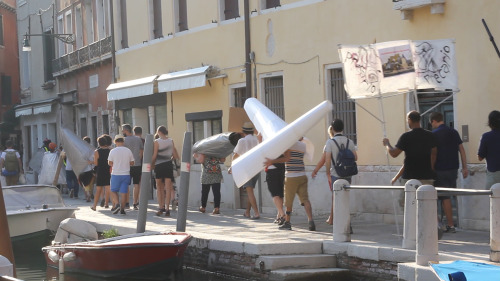
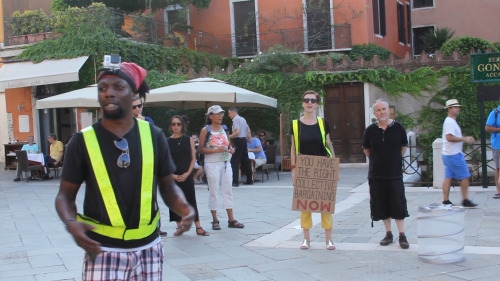
As it turns out Guggenheim administrators were also caught off guard. The museum’s displeasure with the Pageant was compounded by other critiques made during the Venice Biennial that were similarly focused on the Guggenheim’s Abu Dhabi project. Bitterly their ire was conveyed to members of Gulf Labor Coalition, and among other (now familiar) counter-accusations was the assertion that the museum has not exploited any workers in Abu Dhabi because no contract for building the Guggenheim there has been awarded. No exploited workers, no evil empire.
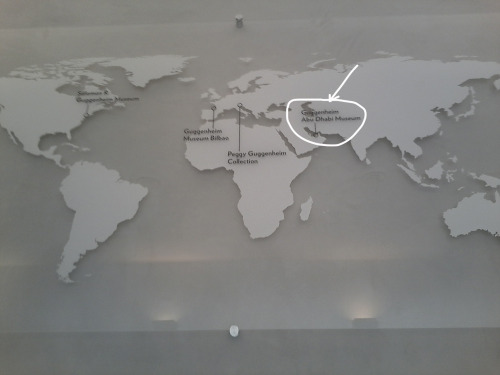
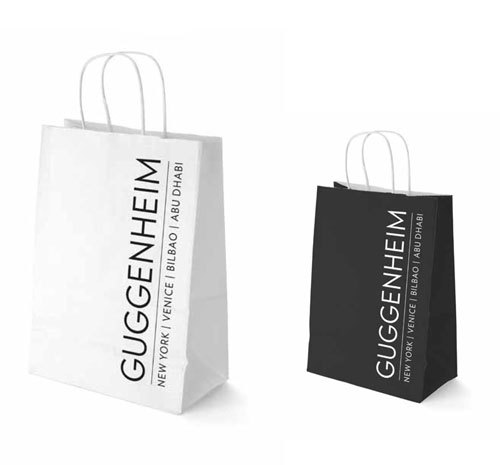
The counterargument is of course a dodge. Not only has the Guggenheim dotted its own colossal boardroom office map with the anticipated Abu Dhabi location, but they also prominently herald the coming new museum on their custom shopping bags. However, if you are of the opinion that the conspicuous rolling-out of one’s imminent plan of action does not truly constitute a line that has already been crossed; then consider the future museum site itself. The Guggenheim Abu Dhabi is literally being constructed on desert sands. Unlike an urban setting where builders can rely on a pre-established support grid for power and water and so forth, everything on Saadiyat Island must be built from the bottom up. That includes roads for trucks to travel on and water lines and power cables for contractors to use. So take a close look at the areal images of the site where the Guggenheim Abu Dhabi is to be raised. Not only do we see roads, ramps and concrete supports already in place, but also the entire museum footprint is a man-made peninsula jutting into the water. Needless to say, the infrastructure for the future Guggenheim Abu Dhabi did not arise spontaneously. Instead, it required labor by migrant workers whose conditions of exploitation are well documented. (In fact, Gulf Labor has already commented on this all too obvious evasion: CLICK )
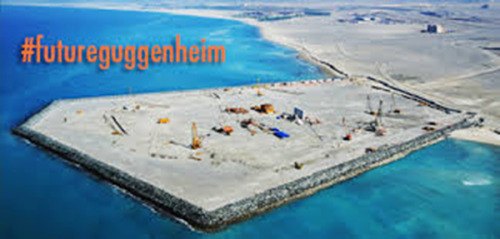
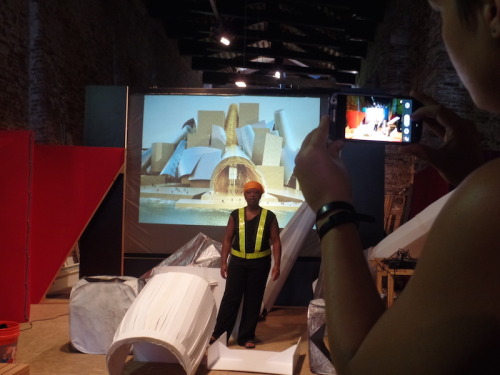
Still, one thing especially vexed the museum. A man with a black porkpie hat, blowing a large bass horn, and wearing a hand-lettered cloak that read: Guggenheim Abu Dhabi Evil-Empire of Art. The egregious phrase was hand-lettered onto a rectangle of canvas and hung like a thespian’s cape off the shoulders of performance artist Jim Costanzo, founder of the Aaron Burr Society. The paint-stiffened cloak declaimed its scalding indictment on a breezeless torrid day -although in Abu Dhabi the heat reached 41c, another five to six degrees hotter still than Venice- and it did not go unnoticed.
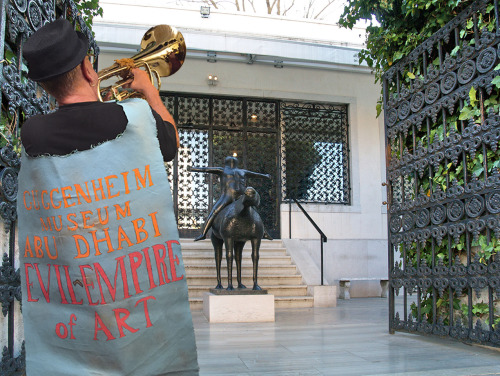
Along with the Precarious Workers Pageant, Costanzo’s theatrics belong to a long tradition of political satire whose practitioners include Honoré Daumier, Bertolt Brecht, Kurt Weil, Hanns Eisler, Lotte Leyna, Dario Fo, the San Francisco Mime Troupe, Carnival Knowledge (the 1980s feminist group), Reverend Billy and the Church of Stop Shopping, Occupy Museums and Pussy Riot. Against the extensive communicational power of mainstream media and established cultural institutions a certain DIY vernacular aesthetic has often been the preferred artistic weapon of the weak, the marginal, and the precarious.
Costanzo’s videos, performances and agitprop projects have often channeled this bottom-up energy, sometimes projecting into the public sphere a state of anger so raw it makes one flinch as in his 2003 piece “The Scream: 21st Century Edition.” Created in the lead-up to the illegal invasion of Iraq and made all the more unfathomable by the unprecedented global demonstrations against such aggression by the United States you can see his video here: CLICK
Years later, he founded the “Aaron Burr Society,” a “mockstitution” whose nom de guerre honors the former US Vice President who railed against the establishment of a centralized banking system. This time Costanzo donned an archaic looking cape and topcoat, trained it down to Wall Street carrying a large, almost obscene sounding baritone trumpet with him (an instrument that he is still struggling to play “properly”) all in an effort to register his personal outrage over the 2008 financial meltdown and the subsequent welfare bailout for the world’s top bankers. CLICK
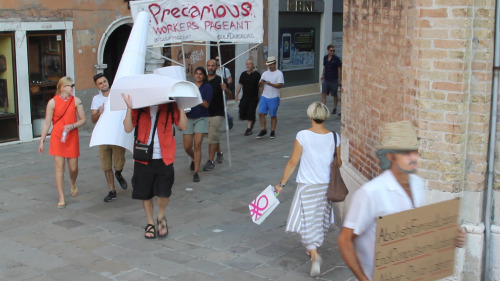
And so, through the steamy streets of Venice Costanzo blew his horn, clearing the way for members of Workers Art Coalition including Barrie Cline, Stephanie Lawal, Eliza Gagnon, Marquis Jenkins, Mirana Zuger and fellow participants from Gulf Labor, G.U.L.F., S.a.L.E. Docs and Social Practice Queens, as the Precarious Workers ostentatious and communal act of institutional critique called upon the planners of the Guggenheim Abu Dhabi to reconsider branding a regime whose abuse of migrant labor is as egregious as it is flagrant. Costanzo’s accusatory cloak was rhetorically embellished, for a reason. Against the extensive reach of mainstream cultural, political and media institutions the surplus army of precarious artists gleefully turns to the carnivalesque, spitting out an often vulgar aesthetics of the street, the circus, or fiesta in order to have their voices heard above the patronizing tones of proper cultural decorousness. Such ribald insurgency has its own dark strengths, even in an age of top-down, empire culture.
